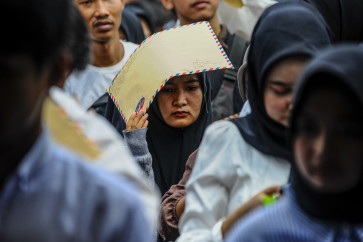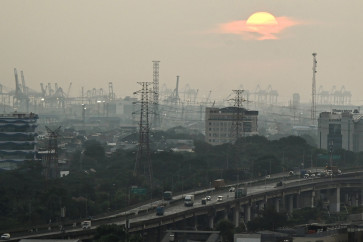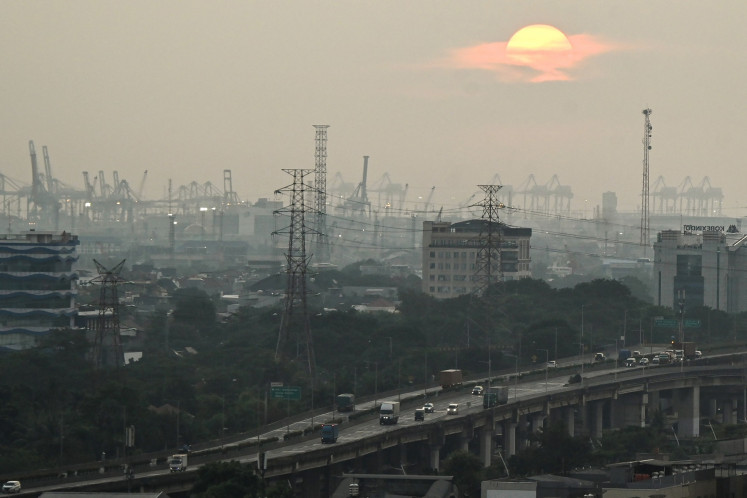Batik Betawi stands out for bright colors, unique motifs
Precious heritage: Modern batik Betawi decorated with a depiction of ondel-ondel (Betawi effigies) and Rumah Si Pitung (Pitung’s House) is sold in a shop at the Thamrin City shopping mall in Central Jakarta on Monday
Change text size
Gift Premium Articles
to Anyone

P
recious heritage: Modern batik Betawi decorated with a depiction of ondel-ondel (Betawi effigies) and Rumah Si Pitung (Pitung’s House) is sold in a shop at the Thamrin City shopping mall in Central Jakarta on Monday. Batik Betawi makers often use bright colors and unique motifs to distinguish their designs from those of other regions, such as Central Java and West Java.(JP/Vela Andapita)
Compared to its famous counterparts from Surakarta and Pekalongan in Central Java or Cirebon in West Java, batik Betawi is never at the top of people’s minds when they talk about the traditional Indonesian fabric. However, its distinctive bright colors and unique motifs make it stand out.
Unlike other types of batik that are dominated by earthly tones like black and brown, batik Betawi comes in bright red, yellow, green, blue and purple. Its recognizable motifs are mostly inspired by traditional Betawi culture, like ondel-ondel (Betawi effigies) or tanjidor musical instruments and the city’s iconic buildings, like the National Monument (Monas).
Anna Setyaningsih, a batik Betawi craftswoman in Central Jakarta, has even created motifs from popular tourist sites, such as Syahbandar Tower in North Jakarta, Baru Market in West Jakarta, the Keong Mas (Golden Snail) building and the Istana Anak-anak Indonesia (Indonesian Children’s Palace) in the Taman Mini Indonesia Indah cultural park in East Jakarta.
“I was driven to make batik Betawi after learning that, back then, it was known as exclusive and expensive. I wanted to change that stereotype by creating affordable batik of high quality,” said Anna, noting that she started the business in 2014.
Anna, whose ancestors are from Yogyakarta, said she had received support from the Central Jakarta administration to market her products. Since January, she has displayed her batik in Thamrin City, Central Jakarta, using a stall provided by the municipality’s Handicraft Board (Dekranasda).
The price of her batik Betawi ranges from Rp 175,000 (US$12) to Rp 500,000, depending on the production technique — cap (stamp) or tulis (hand dyed). Anna’s shop attendant, Isna, said most of the customers were looking for batik with ondel-ondel motifs. Two other best-selling motifs were the Welcome Monument and Rumah Si Pitung (Pitung’s House).
“People mostly buy the fabric, not the ready-to-wear clothes. They come from agencies or companies. They go for bulk purchases to make uniforms for their employees,” Isna said.
A suggestion to wear batik Betawi is stipulated in Bylaw No. 4/2015 on the preservation of Betawi culture and in Gubernatorial Decree No. 11/2017 on Betawi cultural icons. The regulations urge companies and government agencies to use batik Betawi for their employees’ uniforms.
A batik Betawi craftswoman from South Jakarta, Siti Laela, who owns a workshop in Cilandak, said she regularly received orders for uniforms. With the help of her 11 workers, she could sell up to 50 pieces of batik a month.
Betawi artist and historian Yahya Andi Saputra said batik Betawi’s history could be traced back to the early 20th century. Its bright colors represented the openness of people residing in Jakarta’s coastal area. The Betawi craftspeople would interact with batik traders from other parts of the country seeking to sell their products in the city.
“Seeing the beauty of Javanese batik fabric, they were inspired to make their own. They began with cagak or tumpal (triangle) motifs representing the relationship between humans, the universe and the higher power,” Yahya explained.
“Batik Betawi also used to have flora and fauna motifs, but in the early 2000s, batik Betawi craftspeople began to create motifs that were really distinct,” he added.
That transformation, Yahya said, took place decades after the city administration evicted people, including batik Betawi craftspeople, who lived and went about their trade in the heart of the city — places where hundreds of high-rise buildings stand today. In the 1970s, they moved to the suburbs and could not continue their business, hence batik Betawi disappeared from the market.
“With the current motifs, batik Betawi has the ability to stand out again and attract more attention from batik lovers,” Yahya said.









